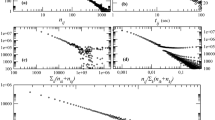Abstract
This chapter argues that the Web, as well as social networks such as Facebook or Twitter, deserve to be subsumed under the notion of cyberspace since they have a special ontological status with respect to garden-variety technical artifacts. While the latter artifacts belong to two distinct ontological categories, namely, concrete particulars and types, social networks are rather abstract particulars, and this entitles us to cast them as sui generis spaces, namely, cyberspaces.
Access this chapter
Tax calculation will be finalised at checkout
Purchases are for personal use only
Similar content being viewed by others
References
Benjamin, W. (1936/2008). The Work of Art in the Age of its Technological Reproducibility, English translation: in The Work of Art in the Age of its Technological Reproducibility and Other Writings on Media. Harvard University Press.
Carpo, M. (2011). The Alphabet and the Algorithm. MIT Press.
Carpo, M. (2020, March). Rise of the Machines. Artforum, pp. 172–180
Carroll, N. (1998). A Philosophy of Mass Art. Clarendon Press.
Chalmers, D. (2005). The Matrix as Metaphysics. In C. Grau (Ed.), Philosophers Explore the Matrix (pp. 132–176). Oxford University Press.
Chalmers, D. (2018). The Virtual and the Real. Disputatio, 9(4), 309–352.
Dodd, J. (2007). Works of Music: An Essay in Ontology. Oxford University Press.
Elder, C. (2004). Real Natures and Familiar Objects. MIT Press.
Evans, G. (1985). Molyneux’s Question. In Collected Papers (pp. 364–399). Clarendon.
Evnine, S. (2016). Making Objects and Events: A Hylomorphic Theory of Artifacts, Actions, and Organisms. Oxford University Press.
Evnine, S. (2019). Mass Production. In B. Brewer & J. Cumpa (Eds.), The Nature of Ordinary Objects (pp. 198–222). Cambridge University Press.
Gibson, W. (1982, July). Burning Chrome. Omni.
Gibson, W. (1984). Neuromancer. Harper.
Kania, A. (2018). Why Gamers Are Not Performers. Journal of Aesthetics and Art Criticism, 76(2), 187–199.
Kittler, F. (1986/1999). Gramophone Film Typewriter. English Translation. Stanford University Press.
Kneale, D. (1996, September 26). From the Man Who Named Cyberspace, a New Trip. Wall Street Journal, Eastern Edition. https://www.wsj.com/articles/SB843620903987895000
Koepsell, D. R. (2000). The Ontology of Cyberspace: Philosophy, Law, and the Future of Intellectual Property. Open Court Publishing.
Lillemose, J., & Kryger, M. (2015). The (Re)invention of Cyberspace. Nordic Art Review, https://kunstkritikk.com/thereinvention-of-cyberspace/
Millikan, R. G. (2000). On Clear and Confused Ideas: An Essay about Substance Concepts. Cambridge University Press.
Morningstar, C., & Farmer, F. R. (2008). The Lessons of Lucasfilm’s Habitat. Journal for Virtual Worlds Research, 1(1), 1–21.
Quine, W. V. O. (1953). From a Logical Point of View. Harvard University Press.
Sider, T. (2011). Writing the Book of the World. Oxford University Press.
Strawson, P. F. (1959). Individuals. Methuen.
Strawson, P. F. (1966). The Bounds of Sense: An Essay on Kant’s Critique of Pure Reason. Methuen.
Terrone, E. (2014). The Digital Secret of the Moving Image. Estetika: The Central European Journal of Aesthetics, LI/VII(1), 21–41.
Terrone, E. (2018). Appearance and History: The Autographic/Allographic Distinction Revisited. The British Journal of Aesthetics, 58(1), 71–87.
Wollheim, R. (1980). Art and its Objects: An Introduction to Aesthetics, 2nd ed.. Revised. Cambridge University Press.
Wolterstorff, N. (1980). Works and Worlds of Art. Clarendon Press.
Author information
Authors and Affiliations
Corresponding author
Editor information
Editors and Affiliations
Rights and permissions
Copyright information
© 2022 The Author(s), under exclusive license to Springer Nature Switzerland AG
About this chapter
Cite this chapter
Terrone, E. (2022). The Cyberspace Strikes Back: An Ontological Account of Social Networks. In: Terrone, E., Tripodi, V. (eds) Being and Value in Technology. Palgrave Macmillan, Cham. https://doi.org/10.1007/978-3-030-88793-3_2
Download citation
DOI: https://doi.org/10.1007/978-3-030-88793-3_2
Published:
Publisher Name: Palgrave Macmillan, Cham
Print ISBN: 978-3-030-88792-6
Online ISBN: 978-3-030-88793-3
eBook Packages: Religion and PhilosophyPhilosophy and Religion (R0)




